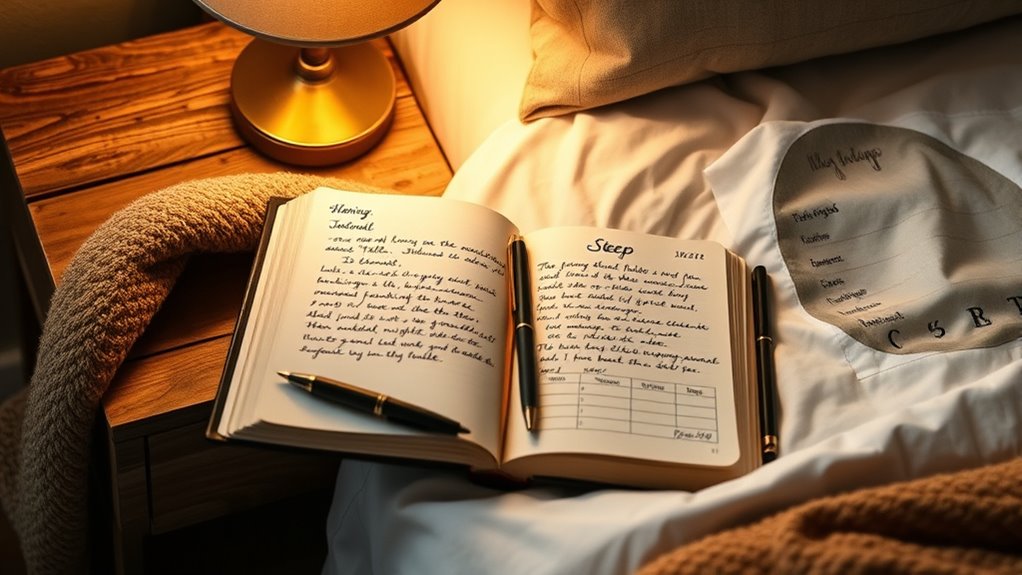To create a bedtime journal that boosts your sleep quality, start by recording your nightly sleep patterns, routines, environment, and any external influences like caffeine or stress. Track factors like room temperature, noise, bedtime activities, and how you feel in the morning. Consistently noting these details helps you spot patterns and identify what disrupts or improves your sleep. Keep journaling regularly, and you’ll discover personalized insights that lead to better rest—if you keep exploring, you’ll find more effective adjustments.
Key Takeaways
- Define clear categories to track, such as sleep environment, routines, and external influences, for comprehensive insights.
- Record details nightly, including bedtime activities, room conditions, and wake-up feelings, to identify patterns.
- Use consistent formatting and timing to ensure accurate, comparable data for effective analysis.
- Analyze journal entries regularly to pinpoint factors affecting sleep quality and areas for adjustment.
- Implement targeted changes based on insights, like modifying routines or environment, and monitor their impact over time.

Ever wonder how keeping a bedtime journal can improve your sleep and well-being? It’s a simple yet powerful tool that helps you understand your sleep patterns and identify habits or environments that may be disrupting your rest. When you start journaling, you become more aware of your sleep environment and how it affects your ability to fall asleep and stay asleep. Your sleep environment includes factors like room temperature, lighting, noise levels, and bedding — all of which can profoundly impact your sleep quality. By tracking these details in your journal, you’ll notice patterns and be able to make targeted changes, like adjusting the thermostat or using blackout curtains, to create a more conducive sleep environment.
Keeping a sleep journal reveals patterns and helps you optimize your sleep environment for better rest.
Your bedtime routine plays an equally crucial role in your sleep quality. When you keep a journal, you can observe how your pre-sleep habits influence your rest. For example, do you feel more relaxed after reading a book or listening to calming music? Or does screen time right before bed leave you tossing and turning? Recording these behaviors helps you recognize what works and what doesn’t, allowing you to refine your routine. Establishing a consistent bedtime routine signals to your body that it’s time to wind down, which can make falling asleep easier. Use your journal to note what activities you do before bed, how long they take, and how they impact your sleep onset and quality.
Creating an effective bedtime journal doesn’t require fancy tools—just a notebook or a simple digital app will do. Set aside a few minutes each night to jot down details about your sleep environment, bedtime routine, and how you feel when you wake up. Be honest and specific; include things like room temperature, light levels, caffeine intake, stress levels, and any disruptions during the night. Over time, this data reveals trends and allows you to experiment with adjustments. For instance, if you notice that late-night caffeine causes restless sleep, you can cut back. If your bed feels uncomfortable, you’ll know to invest in better bedding. Additionally, sleep environment factors such as noise and lighting can be optimized to improve your sleep quality.
The key to success is consistency. The more diligently you record your habits and environment, the clearer your insights become. With these insights, you can make informed changes to optimize your sleep environment and bedtime routine. This proactive approach not only enhances your sleep quality but also boosts your overall well-being. So, start your bedtime journal today, and take control of your sleep health—your body and mind will thank you.
Frequently Asked Questions
Can a Bedtime Journal Help With Insomnia?
Yes, a bedtime journal can help with insomnia by improving your sleep habits and reducing anxiety. You actively track your bedtime routines, note any worries, and identify patterns that disrupt sleep. This process encourages relaxation and self-awareness, which can lessen anxiety about sleeplessness. Over time, journaling creates a calming pre-sleep ritual, helping you unwind and fall asleep more easily, ultimately enhancing your overall sleep quality.
How Long Should I Maintain a Bedtime Journal?
You should maintain your bedtime journal for at least a month to build a consistent habit. This period allows you to track patterns, assess your mood, and identify sleep triggers effectively. Keep recording nightly, focusing on habit tracking and mood assessment, and review your entries weekly. Staying committed helps uncover insights, refine your routine, and improves sleep quality over time, making journaling a valuable tool in your sleep improvement journey.
What Materials Are Best for Journaling at Night?
For nighttime journaling, choose smooth, high-quality paper that won’t bleed through or tear easily. Opt for pens like gel or ballpoint, which glide effortlessly and prevent smudging. Avoid flimsy or rough paper that could cause frustration or damage your writing tools. Using comfortable, reliable materials makes your journaling experience more enjoyable, helping you stay consistent and focused on improving your sleep habits.
Should I Include Dreams in My Bedtime Journal?
Absolutely, including dreams in your bedtime journal is a smart move. Think of it as your personal dream recall and analysis session, like a mini detective story each night. Jot down any dreams you remember, no matter how fleeting. Over time, you’ll notice patterns, symbols, and insights that can help you understand your subconscious better, ultimately improving your sleep quality and waking up more refreshed and aware.
Can a Bedtime Journal Replace Sleep Therapy?
A bedtime journal can’t replace sleep therapy, but it can complement it through effective sleep tracking and journaling techniques. You actively record sleep patterns, habits, and feelings, which helps identify issues and triggers. While journaling enhances self-awareness, professional therapy addresses underlying causes. Use your journal as a helpful tool, not a substitute, to improve sleep quality alongside expert guidance when needed.
Conclusion
A bedtime journal becomes your lighthouse, guiding you safely through the night’s tumult. By pouring your thoughts onto its pages, you create a sanctuary where worries dissolve like shadows at dawn. Each entry is a star, illuminating your path toward restful sleep. Embrace this ritual as a gentle anchor, tethering you to serenity. In the quiet darkness, your journal transforms into a vessel of hope, steering you toward tranquil dreams and brighter mornings.









